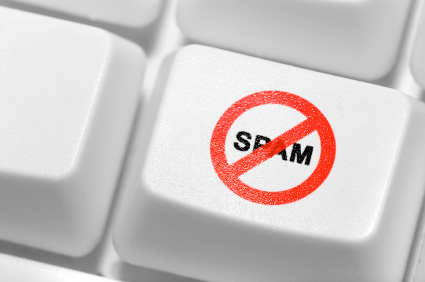Learn the ways to keep your e-mails from getting blacklisted.
By Kirill Popov and Loren McDonald
Every e-mail marketer receives spam complaints. It doesn’t matter if you use confirmed opt-in steps or have never seen a complaint in your life. Your messages do get complaints. Unless you use an e-mail service provider (ESP) or your ESP doesn’t provide these services, you might not have immediate access to these complaints and not know they exist.
It’s useful to know spam complaints for two reasons. First, they indicate how closely you follow best practices. Second, ISPs and anti-spam services use them to filter and even to block messages. Let’s take a look at where complaints generate, how they’re used, and what you can do to minimize them.
How Users Report Spam
There are three primary ways e-mail recipients can file complaints:
- Most large consumer ISPs include a link or button that allows recipients to flag spam messages.
- Recipients can use a spam complaint service, such as SpamCop or Vipul’s Razor.
- Recipients can send complaints directly to e-mail abuse addresses at ISPs and the FTC.
How to Monitor Spam Complaints
To ensure you see the complaints your messages may generate, follow these steps:
- Make sure your “abuse@” and “postmaster@” addresses are valid and can receive e-mail. Get access to those addresses and review the incoming mail. These addresses are recommended Internet standards set by the Internet Engineering Task Force (IETF) for complaint reporting.
- Register the above addresses with abuse.net. It’s a clearinghouse for registered abuse addresses used by many network administrators and tools to route complaints to the proper destination.
- Register for a feedback loop.
- Provide complaint instructions in your privacy and anti-spam policies. Often, less tech-savvy recipients want to complain to you directly, but don’t know how. Link to your privacy policy from the e-mail’s footer.
How ISPs Use Spam Complaints
ISPs use complaints for many reasons. Complaints contribute to ISPs’ content filters, especially the learning filters, to help improve their predictive algorithms. They also use complaints as a sort of voting system to deem whether e-mail coming from a certain IP address is good or bad. Too many complaints may lead to a message being filtered into bulk folders or rejected entirely. ISPs may then require the sender take specific steps, such as reconfirming a mailing list, before allowing more traffic from the sender.
Spam complaint percentages (spam complaints divided by messages sent, multiplied by 100) can vary widely based on list composition, opt-in approach, content type, frequency, your brand, and more.
Some ISPs recommend keeping spam complaints below 1-3 percent of traffic, depending on volume. Or be at or below the range of one complaint per 6,000 to 8,000 messages, or 0.013 percent.
How to Minimize Complaints
Minimizing complaints always starts with practices used to collect e-mail addresses. It should be obvious by now sending unsolicited e-mail only gets you in trouble. Mailing lists with the lowest complaint rates are either confirmed opt-in or properly managed single opt-in. If you have a solid permission-based list but still find incoming complaints are higher than the optimal rate or are rising, consider the following:
- Brand your subject lines. Mail systems with spam complaint buttons offer it at the inbox level. A recipient needs only to scan subject lines and decide which messages not to delete immediately. A subject line such as “Exciting offers for you, Bob!” will surely be marked as spam. Consider using your company or newsletter name in brackets at the beginning of your subject lines.
- Consider including unsubscribe instructions at the top of your e-mail, in addition to the footer. Some users use the “report spam” button as an unsubscribe method and won’t scroll through an entire message to find that link.
- Include instructions for users to whitelist your domain. This prevents a user-based filter from mistaking your message for spam and either diverting it to the spam folder or prefixing “[SPAM]” to the subject of the message.
- Provide a preference update page. Disclose how your organization will use a subscriber’s e-mail addresses, and how often. Allow subscribers to select preferences on the opt-in form, and link from e-mail to a preference or profi le update page.
- Avoid spammy looking content. Try not to use garish, bold fonts; large, red letters, and the like. Avoid images with poor compression quality. A clean, readable design isn’t as likely to be mistaken for spam.
- Don’t over e-mail. If recipients expect to receive a few informational e-mail messages each month from your company, don’t suddenly start sending two or three each week.
- Don’t send unexpected e-mail. If subscribers opted in to receive your “Trends & Tips” newsletter, don’t send them your hard-sell e-commerce messages, unless they clearly requested them.
- Include opt-in information. If possible, add to your e-mail admin area information, such as the subscriber’s e-mail address, date of opt-in, and how she potentially subscribed (product registration, white paper download form, sweepstakes entry, etc). With many subscribers receiving dozens of commercial e-mail messages daily, it’s easy to forget signing up for your newsletter—and then to file a complaint.
Spam complaints are an unavoidable and important aspect of e-mail marketing that can’t be overlooked. In most cases, above-average complaint rates suggest poor e-mail practices that over time lead to decreasing open and click-through rates. In the short term, too many spam complaints simply get your e-mail filtered or blocked.
Reprinted from Email Labs, www.emaillabs.com.










